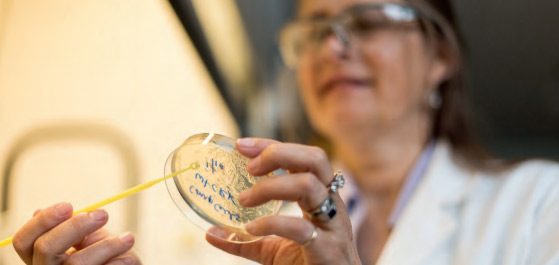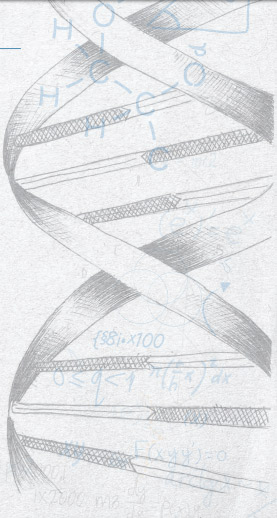
Students at Gettysburg College are practiced at finding connections between their most passionate personal interests and their coursework—and professors know how powerful those connections can be for learning.
Take chemistry Prof. Koren Lipsett, whose research focuses on genomic studies to better understand human disease. Lipsett has owned and rescued horses for many years. Today, in part because of a connection made by one of her students, horses are a focus of her research on deafness in humans.
Horses to humans
By researching genetic diseases in large mammals, Lipsett and students in her lab hope to help researchers better understand how to treat human genetic disorders, such as congenital blindness and deafness. They’ve worked with cats (blindness), cattle (fibroblast growth factor-hair length), and—for the past eight years—deafness in horses.
The inspiration for the horse project came from Suzanne E. DiNello-Schleicher ’10, a biology and chemistry double major—now a veterinarian. While doing some preliminary research for Lipsett’s lab, she came across a story about a deaf colt.
“Because she’s a horse person and a vet person, she said, ‘Maybe we can pursue this,’” said Lipsett. “It turned out that the family that owned that deaf colt also had the parents and siblings in this pedigree of Spanish Mustangs. Not just one offspring was deaf—there were two deaf offspring that came from the same stallion and two different mares. So that started the project.”
In addition to having an affinity for horses, working with them has benefits. They are longer-lived than mice or rats, allowing for long-term studies. The research is humane: Lipsett uses hair plucked from the horse’s mane. Access to the subjects is convenient: her horse and horses from the SPCA are the experimental controls; the deaf horses in the study are in nearby Virginia.
The deaf horses have white coats and blue eyes which, studies have shown, correlate with deafness in other animals—Siberian Husky dogs, for example. This knowledge helped Lipsett’s lab narrow down its focus to a candidate gene called the KIT gene.
“That particular gene is complex, but that’s not the only one that has been found—there are five or six genes that we identified as candidate genes. And our job is to methodically sequence those genes to see if we can find the mutation,” said Lipsett.
Resolute and ongoing
The process involves examining the gene’s exons, the segments of the DNA that contain the coding information, or set of instructions, which translate to the protein of interest.
Benjamin Gantz ’16 was responsible for examining exon-21 in the KIT gene. They ran into several issues when designing primers, which is the first step to sequencing a gene.
“Ben would say, ‘Wow, I’m doing real science,’ and I’d say, ‘You’ve been doing real science the whole time!’ Because you need to think outside the box. There’s no canned answer,” said Lipsett.
“Ben got to a point where we understood where the problem was, and by the time he graduated we had a good understanding of what to do next.”
That’s important because—though dedicated to the work while they are here—students graduate. Faculty inquiry is ongoing—high-quality teaching and research opportunities will greet the next group of Gettysburg College students.
“Many students had worked on this project before me. It was amazing to be able to pick up where they left off and continue this research,” said Gantz. “In independent research labs like Prof. Lipsett’s, you are determining the answers to questions that no one on the planet knows. Other scientists may use our research to further their understanding or study, but our findings will be a starting point for them.”
Lipsett said they have narrowed down which genes to focus on and are consolidating the data order to identify a putative gene mutation. The next step will be to explore the mechanism of pathology that will help define how the gene mutation translates to disease symptoms—like blindness or deafness.
“We can directly correlate it to human studies,” said Lipsett. “The more we understand the gene function in a mammal model, the more likely we can understand the equivalent function in humans. Then we can apply that knowledge to characterize and potentially treat the genetic disorder.”
 Continuing connections
Continuing connections
Findings from the research have already been made available to the greater science community through publications coauthored by students such as Kaytie Innamorati ’14 (a doctoral candidate in molecular and cell biology at Drexel University) and Alecia Achimovich ’16 (a doctoral candidate in biophysics at the University of Virginia). Publishing or making presentations in professional settings are measures of the quality of work of Gettysburg College students.
Another related outcome of benefit to other researchers resulted in a patent award. Lipsett and her colleagues at the National Institute of Standards and Technology designed a technique using what is described as “optical tweezers,” by using an infrared laser to trap and then isolate a single mitochondrion.
Lipsett explained that one characteristic of mitochondria is that each contains multiple copies of the mitochondrial genome—and each cell can contain many mitochondria.
“If there is a mutation in one copy of the genome, and there are 100 copies total, the other 99 copies are fine,” she said. “So why should one copy interfere with the cell?” Lipsett and her colleagues devised their solution to study how one modified copy becomes the predominant version.
The idea to apply for the patent came after a conversation Lipsett had with a former student.
“Christian Bauer ’97, a biochemistry and molecular biology major, went on to get his master’s degree in forensic science,” said Lipsett. Bauer continued his education and became a patent attorney. “He was visiting to speak with students for a career panel, and he said, A‘ a patent—that’s intellectual property!’”
Though her interests are in studying biological pathways, her willingness to explore diverse paths have served Lipsett well. In fact, she didn’t start working with DNA until she came to the College.
“I loved biochemistry in college,” she said. “I didn’t do genomics; I did protein studies. It’s related to the biological system, and that’s what’s exciting to me. My work evolved slowly, as in any research career. You don’t necessarily stay in the same track, but your research takes you down new tracks and lets you solve cool new problems.
“I like learning new tools for finding that needle in the haystack, that Eureka moment.”
